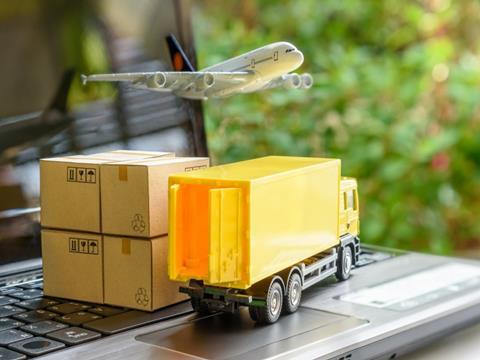
As companies start to answer consumers’ call for sustainability, the need to shrink supply chains is becoming abundantly clear – but how is the sustainability of production and delivery processes being monitored? Could technology be the answer? Drawing on first-hand experience via the Packhelp Pro tool, Packhelp argues the case for digital progress.
The future of supply chain management software solutions
The COVID-19 pandemic has changed supply chains for good. Issues like shortages of products, delays in production, and increasingly high prices have unfortunately become common all around the world.
Companies struggle with a time-consuming process of supplier sourcing, lack of data in terms of logistics and production, inefficient vetting processes, and disjointed communication between the parties involved.
Facing these problems isn’t easy. This is why, according to a McKinsey report, 77% of supply chain professionals plan to increase their supply chain visibility to counteract uncertainties. End-to-end transparency and a data-driven management system seem like the only reasonable way forward.
In this article, we’re going to explore how technology can meet the demands of supply chains for years to come.
The most notable VC investments into packaging-related industries
The pandemic has pushed some ongoing changes in supply chains even further, with digital transformation being one of the most prominent trends in the post-COVID reality.
By leveraging the right tech solutions, we can gain better visibility over our operations, and streamline a long and complicated process.
This trend has also been confirmed by the VC market, with an ongoing rise in funding fueling Supply Chain Management startups. Most of the companies that have recently seen an infusion of venture capital revolve around technologies that address issues like collaboration, visibility, risk management, and sustainability.
Major investments that led the industry include Bizongo’s $173 M in 2021 (Open Marketplace), TemperPack’s $140 M in 2022 (Manufacturing), and Xentral $75 M, also in 2021 (Software).
Sustainability: a challenge for supply chains
The impact of supply chains on climate change and its role in environmental pollution has been widely documented, and it isn’t a pretty picture. The data from McKinsey shows us that a standard consumer company’s supply chain generates both social and environmental costs on a much larger scale than its own operations, with more than 90% negative impact on the environment.
There are 3 main scopes of carbon emissions.
Scope 1 emissions are direct greenhouse (GHG) emissions that occur from sources that are controlled or owned by an organisation.
Scope 2 emissions are a result of the organisation’s energy use, and can be associated with the purchase of electricity, steam, heat, or cooling.
Scope 3 emissions are the result of activities from assets not owned or controlled by the organisation, but that the organisation indirectly impacts in its value chain. It’s where 90% of carbon emissions for most eCommerce brands lie in.
This essentially means that if a company is to become environmentally friendly, it needs to start with its supply chain. It is, after all, what consumers demand when they declare they are willing to spend more on products from eco-friendly brands.
Choosing the right supply chain management software
It’s true that brands of the future build value around sustainability. However, to lead and drive real change, companies must monitor data and impose sustainability standards on the whole supply chain. What should be taken into account while choosing the right software solution for this purpose? Let’s take a closer look.
Suppliers
First and foremost, modern software solutions should provide the possibility of supplier mapping and vetting. By collecting and documenting data about every party involved in the supply chain network, companies can control the effectiveness of their suppliers and the quality of services provided.
Score and verify suppliers on their sustainability efforts to set proper standards, understand pain points and drive improvement. Make sure that the functionalities include gathering the relevant suppliers’ ESG documentation at any point in time.
The platform should also help to spot sustainability issues like emissions and focus on classifying them in terms of the risk level and, in the end, eliminating them right at their origin.
Products
Another must-have feature is an overview of all possible metrics related to products. Evaluate the materials used during production, their source and volume for each of your products.
Choose ones that are recyclable or biodegradable, but make sure they contain the right certificates. A good supply chain management platform should enable it.
Moreover, track how the packaging is shipped to your customers and how it is stored along the way. Be aware of the duties and additional charges. Knowing the way products go to reach the final destination is crucial to calculating carbon footprint.
Processes
A good supply chain management platform should provide a business with a birds’ eye view of the entire production process to detect problems early and react accordingly. A single source of truth means plenty of data which can be leveraged to significantly increase operational efficiency. Standardisation leads to increased consistency and reduces the negative impact of unpredictable market changes.
All parties need to be on the same page during all stages of production and logistics, especially when it comes to multi-stakeholder project management. That is why instant internal and external communication also plays a key role in such platforms.
Ensuring sustainability isn’t only a matter of procedures and communication. It takes the whole supply chain to make an actual change, and new technologies can help us make it happen.
Summary
Supply chains are now more complex than ever. Software solutions need to take various factors into account in order to ensure maximum control over operations and be able to meet companies’ expectations. A focus on cost optimisation, sustainability and streamlined collaboration with suppliers is needed in order to ensure supply chain resilience.
With the right approach, tech solutions have the potential to revolutionise the industry as a whole and make ongoing supply chain disruptions a thing of the past.











No comments yet